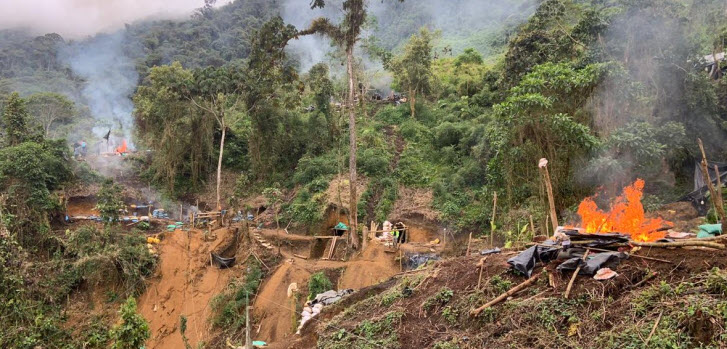Organized crime, illegal mining, and illicit gold trafficking between Ecuador and China have increased significantly in recent years, the Organization of American States (OAS) said in a report.
These problems prompted Ecuador to declare illegal mining a national security threat on Jan. 26.
According to the OAS report “On the Trail of Illicit Gold Proceeds: Strengthening the Fight Against Illegal Mining Finance – Ecuador’s Case,” the country exported nearly four times the amount of gold that Colombia and Peru combined in 2019.

More than 99%t of these exports went to China.
The report points to a notable and growing discrepancy in the reported value of gold trade flows between the Andean country and China.
Officially, Ecuador reported exporting US$76.6 million worth of gold to China in 2019, but Beijing said US$339.2 million, which suggests the commercialization of illicit gold.
The OAS report shows that criminals are innovating and adapting their methods of laundering assets supported by trade to export large amounts of illicit gold to international buyers.
The increase in the outflow of Ecuadorian gold to China and the use of false invoices in recent years deserve particular attention.
Gold accounts for the largest share of Ecuador’s precious metals exports, about 95%.
According to official data, minerals are mined illegally in 20 of Ecuador’s 24 provinces, including national parks.
Illegal mining devastates and contaminates large parts of the country, with the Amazon among the hardest hit areas.
In Ecuador’s northern Amazon region, illegal mining increased by 58% between 2021 and 2022.
Associated destruction of the forest and Rio Punino has reached 217 hectares, with 185 hectares destroyed in 2022, reports environmental journalism news site Mongabay.
THREAT TO SECURITY
The OAS report highlights that Ecuadorian criminal gangs and organizations from neighboring countries exploit the porous border with Colombia and Peru to penetrate Ecuador’s illegal mining supply chains.
According to the report, Colombian criminal gangs, armed groups such as the National Liberation Army (ELN), dissident members of the Revolutionary Armed Forces of Colombia (FARC), and even trans-regional criminal gangs are involved in the illegal gold trade in Ecuador.
Criminal organizations are involved in extorting illegal miners, financing, smuggling illicit equipment, mining, and chemicals, and transporting and laundering illegal gold.
Meanwhile, according to the OAS report, Colombian criminals smuggle dismantled gold mining machinery into Ecuador.
In January, Ecuador’s Deputy Minister of Mines Xavier Vera Grunauer told the Ecuadorian daily Primicias that “the way these groups operate involves a whole structure: from the exploitation of people, armed security and food to the commercialization and distribution of mining materials.”
To address the situation, Ecuador declared illegal mining a “threat to the integral security of the state” because this scourge is part of the chain of drug trafficking, arms trafficking, and money laundering, according to the Ecuadorian government.
Ecuadorian Secretary of State for Security Diego Ordóñez said the government would support legally registered mining concessions and introduce audits, controls, and government monitoring of activities contributing to illegal mining.
He added that measures would include sanctions reviews and the involvement of the armed forces and police in control operations.
To complement Ecuador’s efforts to develop the legal mining sector as an engine for economic growth and investment, buyers, regardless of their country of origin, must comply with regulations and standards, giving the mining sector long-term sustainability.

